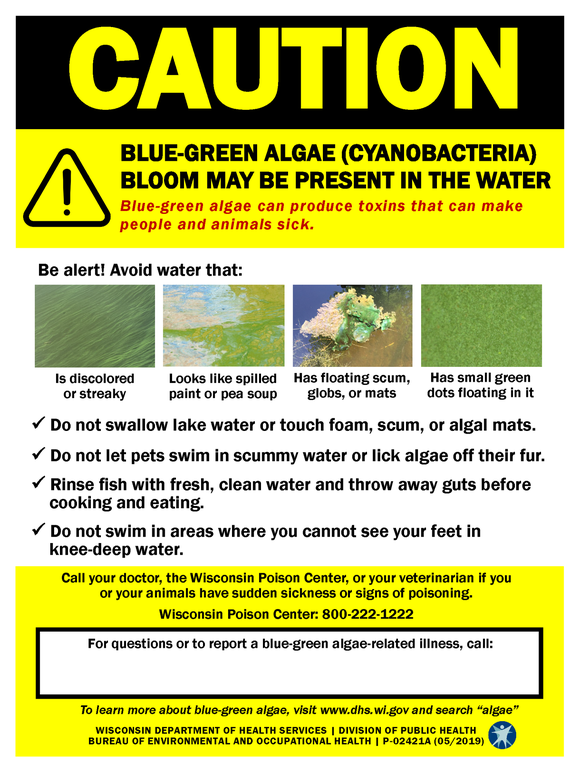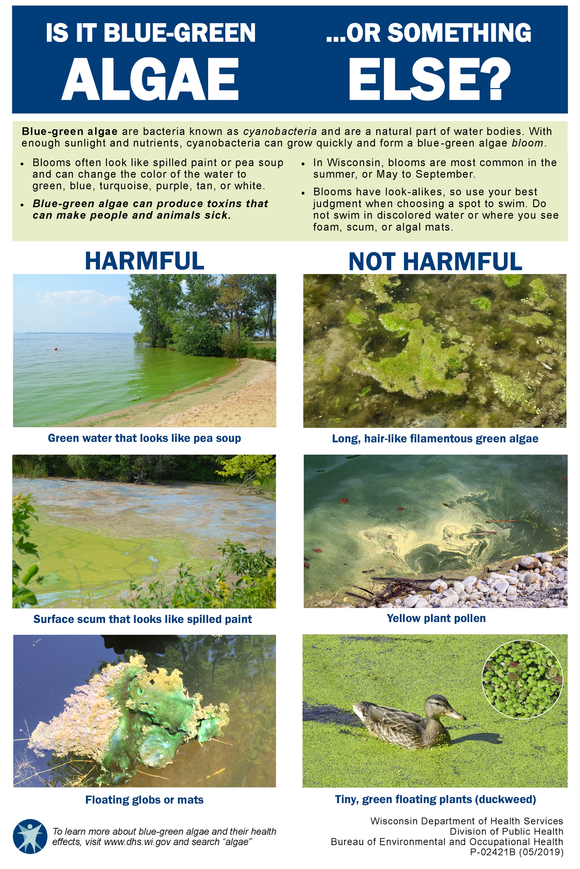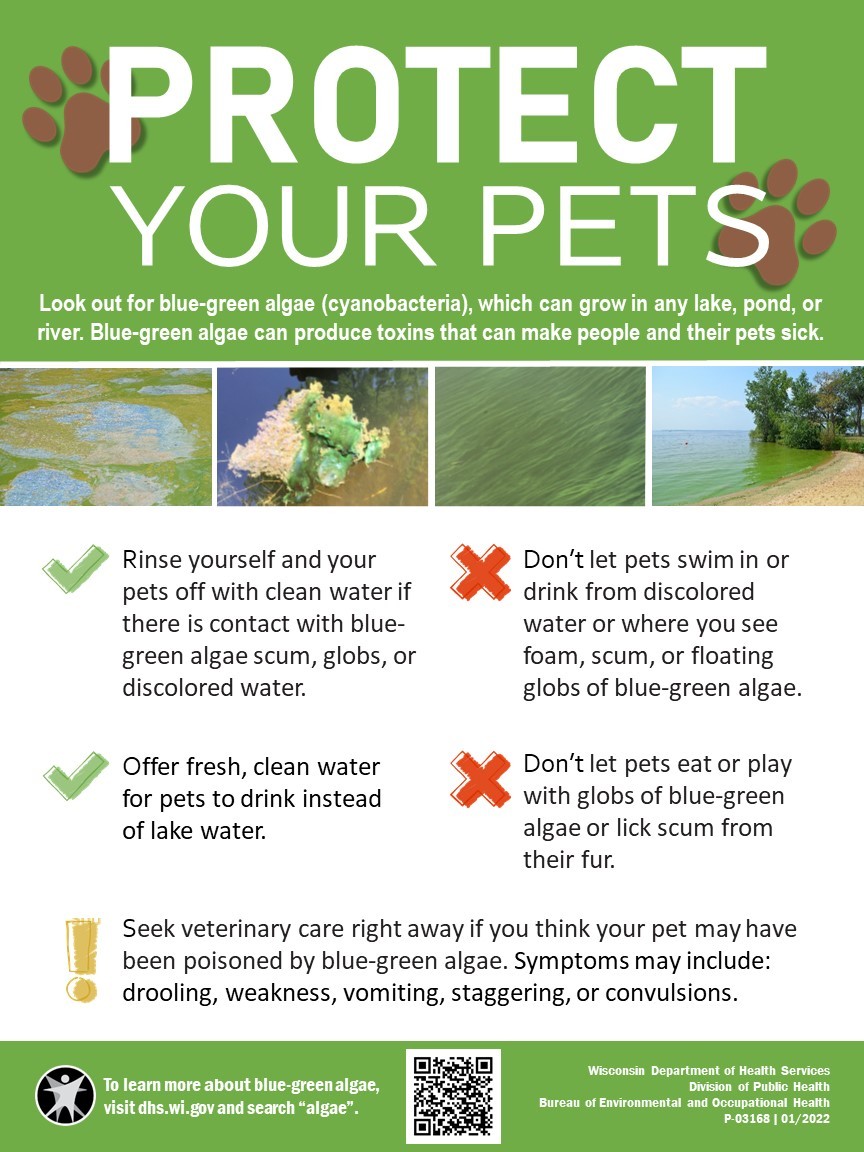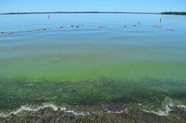
The 2022 HAB season is right around the corner and the DHS HAB program is here to help! In this issue we will provide you with the information and resources you need to effectively respond to HABs and related illnesses. We will also highlight our available signage, which includes our newest pet safety sign. Below are some FAQs and quick links to resources to help you prepare. Be sure to save this email for quick future reference!
FAQs
What if I receive a report of a blue-green algae bloom?
If you receive a report of a bloom without an accompanying illness, report the bloom to the Wisconsin Department of Natural Resources (DNR). Include descriptions of bloom size, duration, and location with lake, town, and county name, as well as any photos taken both close-up and farther away. The DNR is unable to sample and test in response to each bloom report, but may be able to confirm, from submitted photos, whether cyanobacteria are present. Please note that this email address is monitored during normal business hours, so responses to reports received outside business hours may be delayed.
What if I receive a report of a human illness suspected of being related to blue-green algae?
Blue-green algae (cyanobacteria) and cyanotoxin poisoning is now a Category II reportable condition in Wisconsin. Cases must be reported to the local public health department or tribal health center of the jurisdiction where the ill person resides within 72 hours of case recognition. Local health departments should report the suspect case to WEDSS as soon as possible and reference the Case Reporting and Investigation Protocol for guidance. Due to the complexity of case investigation and risk assessment, the DPH HAB Program will work with local health and tribal agencies on case investigations. The HAB Program has been investigating suspect cases of HAB-related illness for 10 years and will continue to offer technical assistance, including possible water sampling, to local health and tribal agencies during case investigations.
What if I receive a report of an animal illness suspected of being related to blue-green algae?
Report the suspect case to the DHS HAB Program. The HAB Program will work with the local health agency to investigate the illness. Animal illnesses suspected of being caused by blue-green algae are important to report because they may serve as sentinels for human illness.
Who has the authority to close a public beach or swim area due to a human health hazard (e.g., blue-green algae), and when can they do it?
Per Wis. Stat. § 254.46, “the local health officer…shall close or restrict swimming, diving and recreational bathing if a human health hazard exists in any area used for these purposes on a body of water and on associated land in their jurisdiction and shall require posting of the area.” Local health departments and tribal agencies have primary authority for issuing health advisories, beach or water body closures, and public messaging. An exception exists for state parks and Great Lakes beaches; at many of these locations, the DNR will post signage and close public beaches.
Local health and tribal authorities can issue a health advisory and close a public beach due to blue-green algae when testing OR visual observation suggests a high probability of adverse human health effects (>100,000 cells/mL cyanobacterial cell density, elevated cyanotoxin concentrations, OR a visible cyanobacteria scum layer is present).
Quick Links
Signage
Did you know that the DHS HAB Program offers signage for local agencies to post? If you would like to purchase a sign, please complete this order form. Completed order forms and questions about ordering should be directed to Megan Rodriguez at Badger State Industries by email or by calling 608-240-5257. Signs are made of high quality aluminum and are offered in 9”x12” and 12”x18” sizes. Metal 6.5’ stakes are also available for purchase.
Note: Only officials at local public health and tribal governmental agencies, and State Parks and State Forests operated by the Department of Natural Resources, may place an order for these signs. Others who wish to use these signs must coordinate with their local health officer.
Guidance for Signage Use
Who can post these signs?
Per Wis. Stat. § 254.46, “the local health officer…shall close or restrict swimming, diving and recreational bathing if a human health hazard exists in any area used for these purposes on a body of water and on associated land in their jurisdiction and shall require posting of the area.” Local health departments and tribal agencies have primary authority for issuing health advisories, beach or water body closures, and public messaging within their jurisdictions. An exception exists for State Parks, State Forests, and some Great Lakes beaches; at many of these locations, the DNR will post signage and close public beaches.
What are the intended uses for these signs? Scan Before You Swim, Caution, and Cyano ID signs are intended to advise beachgoers and other visitors to a water body about potentially hazardous cyanobacterial bloom conditions. Public access locations (e.g., beaches and boat launches) on lakes with a known history of blooms should be prioritized. These signs can be posted throughout the recreational swim season (Memorial Day–Labor Day) but should be removed once the swim season concludes.
Beach Closed signs can be posted when testing OR visual observation of a public swim area suggests a high probability of adverse human health effects (>100,000 cells/mL cyanobacterial cell density, elevated cyanotoxin concentrations, OR a visible cyanobacteria scum layer is present). Authorities should reference Section IV of the Blue-green Algae Case Reporting and Investigation Protocol and contact the DPH HAB Program with additional questions and for guidance surrounding issuing beach closures.
Authorities should place their name and contact information on the bottom of the "Scan...," "Caution," and "Beach Closed" signs.
Introducing our newest sign! Protect Your Pets is intended to be posted at dog swim areas throughout Wisconsin throughout the recreational swim season. This sign aims to inform pet owners to be on the lookout for HABs in the water as well as provide guidance for best practices to protect people and their pets from HABs.
Are art files also available? Yes, approved art files (PDFs) can be requested by emailing the DHS HAB Program.





 |
|
Let's Get Social!
|
 |
|
This issue's sample post
Did you know the season for cyanobacterial harmful algal blooms in Wisconsin usually begins in May? Warmer temperatures help cyanobacteria grow and form blooms. Remember to keep yourself and your pets out of discolored, scummy water and report blooms and related illnesses to your local health department!
|
Stay in Touch
 |
|
Missed a past issue? Previous issues are available on our Resources for Health Professionals webpage.
Email us your burning questions! If others can benefit from hearing the answer to your question, we’ll feature it in a future issue.
Remember that we are always available for consultation on any HAB health-related issue by email or phone (608-266-1120).
|
|